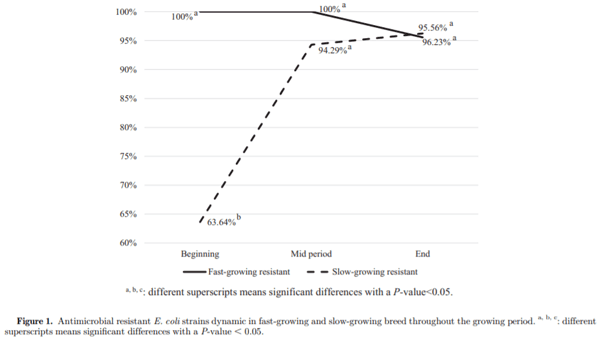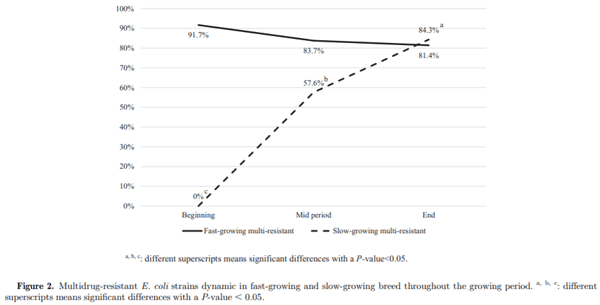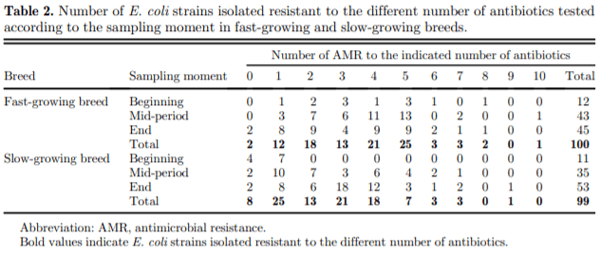The dynamic of antibiotic resistance in commensal Escherichia coli throughout the growing period in broiler chickens: fast-growing vs. slow-growing breeds
1 Instituto de Ciencia y Tecnología Animal, Universitat Politecnica de Valencia, 46022, Valencia, Spain; 2 Centro de Calidad Avícola y Alimentacion Animal de la Comunidad Valenciana (CECAV), Castellón, Spain; 3 Centro de Investigación y Tecnología Animal, Instituto Valenciano de Investigaciones Agrarias, Castellón, Spain; 4 Area de Microbiología, Departamento de Farmacia, Instituto de Ciencias Biomedicas, Facultad de Ciencias de la Salud, Universidad Cardenal Herrera-CEU, CEU Universities, Calle Ramon y Cajal s/n, 46115, Alfara del Patriarca, Spain; 5 Departamento de Produccion y Sanidad Animal, Salud Pública Veterinaria y Ciencia y Tecnología de los Alimentos, Instituto de Ciencias Biomédicas, Facultad de Veterinaria, Universidad Cardenal Herrera-CEU, CEU Universities, Avenida Seminario s/n, 46113 Moncada, Spain.
Antimicrobial resistance (AMR) is an important threat to public health worldwide. Furthermore, different studies have demonstrated a close association be-tween antibiotic use in animal production and AMR in humans. It is well known that it is necessary to reduce antibiotic administration in farms by finding effective alternative treatments, using more resistant breeds and improving animal welfare. However, to be able to assess the alternatives proposed, it is essential to study the epidemiology of AMR under production conditions. Hence, the aim of this study was to investigate the AMR dynamic in 2 genetic poultry breeds during the growing period. The study was performed in 2 experimental poultry houses to simulate real production conditions, and no antibiotics were administered during the growing period. In addition, 2 poultry breeds were used, fast-growing and slow-growing. To evaluate AMR evolution, Escherichia coli was selected as indicator bacterium. To this end, animals from each experimental group were sampled at different times: on day of arrival, at mid-period, and at slaughter day. In the lab-oratory, cecal content was removed and inoculated in selective media. Then, biochemical tests were performed to confirm E. coli. Finally, antibiotic susceptibility was assessed according to Decision 2013/653. At the onset of the cycle, significant differences were observed between breeds, as the E. coli strains isolated from fast-growing 1-day-old-chicks showed higher AMR rates. However, at the end of the period, no significant differences were found between breeds and their presence of resistant bacteria (above 95%). Therefore, although no antibiotics were administered during the growing period, a high level of AMR at slaughter day was demonstrated. Further studies are necessary to determine the main risk factors that increase the level of AMR throughout the productive cycle in broiler chickens. In conclusion, it is important to highlight that although it is crucial to control both antibiotic use and animal welfare during the growing period, measures should be taken at all levels of the production chain.
Key words: antimicrobial resistance, multidrug-resistance, broiler, growing period, Escherichia coli.




Agyare, C., V. E. Boamah, C. N. Zumbi, and F. B. Osei. 2018. Anti-biotic use in poultry production and its effects on bacterial resis-tance. Pages 1–20 in Antimicrobial Resistance – A Global Threat. Yashwant Kumar, ed. InTech Open Science, London, United Kingdom.
Alagawany, M., M. E. Abd El-Hack, M. R. Farag, S. Sachan, K. Karthik, and K. Dhama. 2018. The use of probiotics as eco-friendly alternatives for antibiotics in poultry nutrition. Environ. Sci. Pollut. Res. Int. 25:10611–10618.
Allen, H. K., J. Donato, H. H. Wang, K. A. Cloud-Hansen, J. Davies, and J. Handelsman. 2010. Call of the wild: antibiotic resistance genes in natural environments. Nat. Rev. Microbiol. 8:251–259.
Alos, J. 2015. Resistencia bacteriana a los antibioticos: una crisis global. Enferm. Infecc. Microbiol. Clin. 33:692–699.
Ayandiran, T. O., L. Falgenhauer, J. Schmiede, T. Chakraborty, and F. A. Ayeni. 2018. High resistance to tetracycline and ciprofloxacin in bacteria isolated from poultry farms in Ibadan, Nigeria. J. Infect. Dev. Ctries. 12:462–470.
Bengtsson-Palme, J., E. Kristiansson, and D. G. J. Larsson. 2018. Environmental factors influencing the development and spread of antibiotic resistance. FEMS Microbiol. Rev. 42.
Borjesson, S., S. Ny, M. Egervarn, J. Bergstrom, A. Rosengren, S. Englund, S. Lofmark, and S. Byfors. 2016. Limited dissemina-tion of extended-spectrum beta-lactamase- and plasmid-encoded
AmpC-producing Escherichia coli from food and farm animals, Sweden. Emerg. Infect. Dis. 22:634–640.
Castellini, C., and A. Dal Bosco. 2017. Poultry quality evaluation: quality attributes and consumer values. Pages 335–357 in Animal Welfare and Poultry Meat in Alternative Production Systems (and Ethics of Poultry Meat Production). Woodhead Publishing Series in Food Science, Technology and Nutrition, Elservier Ltd.
Chang, Q., W. Wang, G. Regev-Yochay, M. Lipsitch, and W. P. Hanage. 2015. Antibiotics in agriculture and the risk to human health: how worried should we be? Evol. Appl. 8:240–247.
Chantziaras, I., F. Boyen, B. Callens, and J. Dewulf. 2013. Correlation between veterinary antimicrobial use and antimicrobial resistance in food-producing animals: a report on seven countries. J. Anti-microb. Chemother. 69:827–834.
Cheng, G., H. Hao, S. Xie, X. Wang, M. Dai, L. Huang, and Z. Yuan. 2014. Antibiotic alternatives: the substitution of antibi-otics in animal husbandry? Front. Microbiol. 5:217.
Daehre, K., M. Projahn, T. Semmler, U. Roesler, and A. Friese. 2017. Extended-spectrum beta-lactamase-/AmpC beta-lactamase-pro-ducing Enterobacteriaceae in broiler farms: transmission dynamics at farm level. Microb. Drug Resist. 24:511–518.
EFSA and ECDC (European Food Safety Authority and European Centre for Disease Control) 2016. EU Protocol for Harmonised Monitoring of Antimicrobial Resistance in Human Salmonella and Campylobacter Isolates. ECDC, Stockholm.
EFSA and ECDC (European Food Safety Authority and European Centre for Disease Control) 2018. The European Union summary report on antimicrobial resistance in zoonotic and indicator bac-teria from humans, animals and food in 2016. EFSA J. 16:5182.
EFSA and ECDC (European Food Safety Authority and European Centre for Disease Control) 2019. Technical specifications on harmonised monitoring of antimicrobial resistance in zoonotic and indicator bacteria from food-producing animals and food. EFSA J. 17:5709.
ESVAC (European Medicines Agency) 2017. Sales of Veterinary Antimicrobial Agents in 30 European Countries in 2015. Trends from 2010 to 2015. Seventh ESVAC Report. Accessed December 2019. https://www.ema.europa.eu/en.
European Union 2003. Regulation (EC) No 1831/2003 of the European Parliament and of the Council of 22 September 2003 on Additives for Use in Animal Nutrition (Text with EEA Relevance). Accessed December 2019. https://eur-lex.europa.eu/homepage. html?locale5en.
European Union 2013. Commission Implementing Decision 2013/653 of 12 November 2013 as Regards a Union Financial Aid towards a Coordinated Control Plan for Antimicrobial Resistance Moni-toring in Zoonotic Agents in 2014 (Notified under Document C (2013) 7289). Accessed December 2019. https://eur-lex.europa. eu/homepage.html?locale5en.
Founou, L. L., R. C. Founou, and S. Y. Essack. 2016. Antibiotic resistance in the food chain: a developing country-perspective. Front. Microbiol. 7:1881.
Gadde, U., W. H. Kim, S. T. Oh, and H. S. Lillehoj. 2017. Alternatives to antibiotics for maximizing growth performance and feed effi-ciency in poultry: a review. Anim. Health Res. Rev. 18:26–45.
Guo, X., R. D. Stedtfeld, H. Hedman, J. N. S. Eisenberg, G. Trueba, D. Yin, J. M. Tiedje, and L. Zhang. 2018. Antibiotic resistome associated with small-scale poultry production in rural Ecuador. Environ. Sci. Technol. 52:8165–8172.
Hancock, R. E., A. Nijnik, and D. L. Philpott. 2012. Modulating im-munity as a therapy for bacterial infections. Nat. Rev. Microbiol. 10:243–254.
Horigan, V., R. D. Kosmider, R. A. Horton, L. Randall, and R. R. Simons. 2016. An assessment of evidence data gaps in the investigation of possible transmission routes of extended spectrum b-lactamase producing Escherichia coli from livestock to humans in the UK. Prev. Vet. Med. 124:1–8.
Hussain, A., S. Shaik, A. Ranjan, N. Nandanwar, S. K. Tiwari, M. Majid, R. Baddam, I. A. Qureshi, T. Semmler, L. H. Wieler, M. A. Islam, D. Chakravortty, and N. Ahmed. 2017. Risk of transmission of antimicrobial resistant Escherichia coli from commercial broiler and free-range retail chicken in India. Front. Microbiol. 8:2120.
Jimenez-Belenguer, A., E. Domenech, A. Villagra, A. Fenollar, and M. A. Ferrus. 2016. Antimicrobial resistance of Escherichia coli isolated in newly hatched chickens and effect of amoxicillin treat-ment during their growth. Avian Pathol. 45:501–507.
Kern, W. V. 2018. Multiresistant bacteria - antibiotic prescription and antibiotics of last resort. Dtsch. Med. Wochenschr. 143:643–650.
Khurana, A., R. Shina, and M. Nagaraju. 2017. Antibiotic Resistance in Poultry Environment: Spread of Resistance from Poultry Farm to Agricultural Field. Centre for Science and Environment, New Delhi.
Koga, V. L., S. Scandorieiro, E. C. Vespero, A. Oba, B. G. de Brito, K. C. de Brito, G. Nakazato, and R. K. Kobayashi. 2015. Com-parison of antibiotic resistance and virulence factors among Escherichia coli isolated from conventional and free-range poultry. Biomed. Res. Int. 2015:618752.
Liu, Y. Y., Y. Wang, T. R. Walsh, L. X. Yi, R. Zhang, J. Spencer, Y. Doi, G. Tian, B. Dong, X. Huang, L. F. Yu, D. Gu, H. Ren, X. Chen, L. Lv, D. He, H. Zhou, Z. Liang, J. H. Liu, and J. Shen. 2016. Emergence of plasmid-mediated colistin resistance mechanism MCR-1 in animals and human beings in China: a microbiological and molecular biological study. Lancet Infect. Dis. 16:161–168.
Lusk, J. L. 2018a. Consumer Beliefs, Knowledge, and Willingness-To-Pay for Sustainability-Related Poultry Production Practices Broiler Survey Report. Food Marketing Institute Foundation, Animal Agriculture Alliance, and the Foundation for Food and Agriculture Research.
Lusk, J. L. 2018b. Consumer preferences for and beliefs about slow growth chicken. Poult. Sci. 97:4159–4166.
Marshall, B. M., and S. B. Levy. 2011. Food animals and antimicro-bials: impacts on human health. Clin. Microbiol. Rev. 24:718–733.
Matuschek, E., D. F. Brown, and G. Kahlmeter. 2014. Development of the EUCAST disk diffusion antimicrobial susceptibility testing method and its implementation in routine microbiology labora-tories. Clin. Microbiol. Infect. 20:O255–O266.
Mehdi, Y., M. P. Letourneau-Montminy, M. L. Gaucher, Y. Chorfi, G. Suresh, T. Rouissi, S. K. Brar, C. C^ote, A. A. Ramirez, and S. Godbout. 2018. Use of antibiotics in broiler production: global impacts and alternatives. Anim. Nutr. 4:170–178.
MAPA (Ministry of Agriculture, Fishing and Food) 2018. Informe JIACRA España. Primer analisis integrado del consumo de anti-bioticos y su relacion con la aparicion de resistencia. Accessed July 2019. http://www.resistenciaantibioticos.es/es/publicaciones/ informe-jiacra-espana.
Okorafor, O. N., M. U. Anyanwu, E. O. Nwafor, G. N. Anosa, and R. I. Udegbunam. 2019. Multidrug-resistant enterobacteria colo-nize commercial day-old broiler chicks in Nigeria. Vet. World 12:418–423.
Osman, K. M., A. D. Kappell, M. Elhadidy, E. ElMougy, W. A. A. El-Ghany, A. Orabi, A. S. Mubarak, T. M. Dawoud, H. A. Hemeg, I. M. I. Moussa, A. M. Hessain, and H. M. Y. Yousef. 2018. Poultry hatcheries as potential reser-voirs for antimicrobial-resistant Escherichia coli: a risk to public health and food safety. Sci. Rep. 8:5859.
Polycarpo, G. V., I. Andretta, M. Kipper, V. C. Cruz-Polycarpo, J. C. Dadalt, P. H. M. Rodrigues, and R. Albuquerque. 2017. Meta-analytic study of organic acids as an alternative performance-enhancing feed additive to antibiotics for broiler chickens. Poult. Sci. 96:3645–3653.
PRAN (Plan Nacional Resistencia Antibioticos) 2018. Antibioticos críticos. Accessed June 2019. http://resistenciaantibioticos.es/es/ profesionales/vigilancia/antibioticos-criticos.
Projahn, M., K. Daehre, U. Roesler, and A. Friese. 2017a. Extended-spectrum beta-lactamase and plasmid-encoded cephamycins-pro-ducing enterobacteria in broiler hatchery as a potential mode of pseudovertical transmission. Appl. Environ. Microbiol. 83:e02364.
Projahn, M., K. Daehre, T. Semmler, S. Guenther, U. Roesler, and A. Friese. 2017b. Environmental adaptation and vertical dissemi-nation of ESBL-/pAmpC-pro- ducing Escherichia coli in an inte-grated broiler produc- tion chain in the absence of antibiotic treatment. Microb. Biotechnol. 11:1017–1026.
Ross. 2019. Ross 308/Ross 308 FF broiler: performance objectives. Accessed June 2019. http://es.aviagen.com/assets/Tech_Center/ Ross_Broiler/Ross308-308FF-BroilerPO2019-EN.pdf.
Sevilla-Navarro, S., C. Marín, V. Cortes, C. García, S. Vega, and P. Catala-Gregori. 2018. Autophage as a control measure for Sal-monella in laying hens. Poult. Sci. 97:4367–4373.
Sharma, C., N. Rokana N, M. Chandra M, B. P. Singh, R. D. Gulhane, J. P. S. Gill, P. Ray P, A. K. Puniya, and H. Panwar. 2018. Antimicrobial resistance: its surveillance, impact, and alternative management strategies in dairy animals. Front. Vet. Sci. 8:237.
Sirri, F., C. Castellini, M. Bianchi, M. Petracci, A. Merluzzi, and A. Franchini. 2011. Effect of fast-, medium- and slow-growing strains on meat quality of chickens reared under the organic farming method. Animal 5:312–319.
Spain 2013. Royal Degree 53/2013, 1st of Febrary, por el que se establecen las normas basicas aplicables para la proteccion de los animales utilizados en experimentacion y otros fines científicos, incluyendo la docencia. Boletín Oficial del Estado 34:11370–11421.
Suresh, G., R. K. Das, S. Kaur Brar, T. Rouissi, A. Avalos Ramirez, Y. Chorfi, and S. Godbout. 2018. Critical Reviews in Microbiology Alternatives to antibiotics in poultry feed: molecular perspectives. Crit. Rev. Microbiol. 44:318–335.
Szmolka, A., and B. Nagy. 2013. Multidrug resistant commensal Escherichia coli in animals and its impact for public health. Front. Microbiol. 4:258.
Valls, M. 2017. Reproductoras & pollos crecimiento lento. Accessed June 2019. https://avicultura.info/reproductoras-y-pollos-de-crecimiento-lento/.
Westphal-Settele, K., S. Konradi, F. Balzer, J. Sch€onfeld, and R. Schmithausen. 2018. The environment as a reservoir for anti-microbial resistance: a growing problem for public health? Bun-desgesundheitsblatt Gesundheitsforschung Gesundheitsschutz 61:533–542.
WHO (World Health Organization) 2014. Antimicrobial Resistance: Global Report on Surveillance 2014. Accessed June 2019. https:// www.who.int/drugresistance/documents/surveillancereport/en/.
Zhang, X., B. Zhang, Y. Guo, J. Wang, P. Zhao, J. Liu, and K. He. 2019. Colistin resistance prevalence in Escherichia coli from domestic animals in intensive breeding farms of Jiangsu Province. Int. J. Food Microbiol. 291:87.









.jpg&w=3840&q=75)